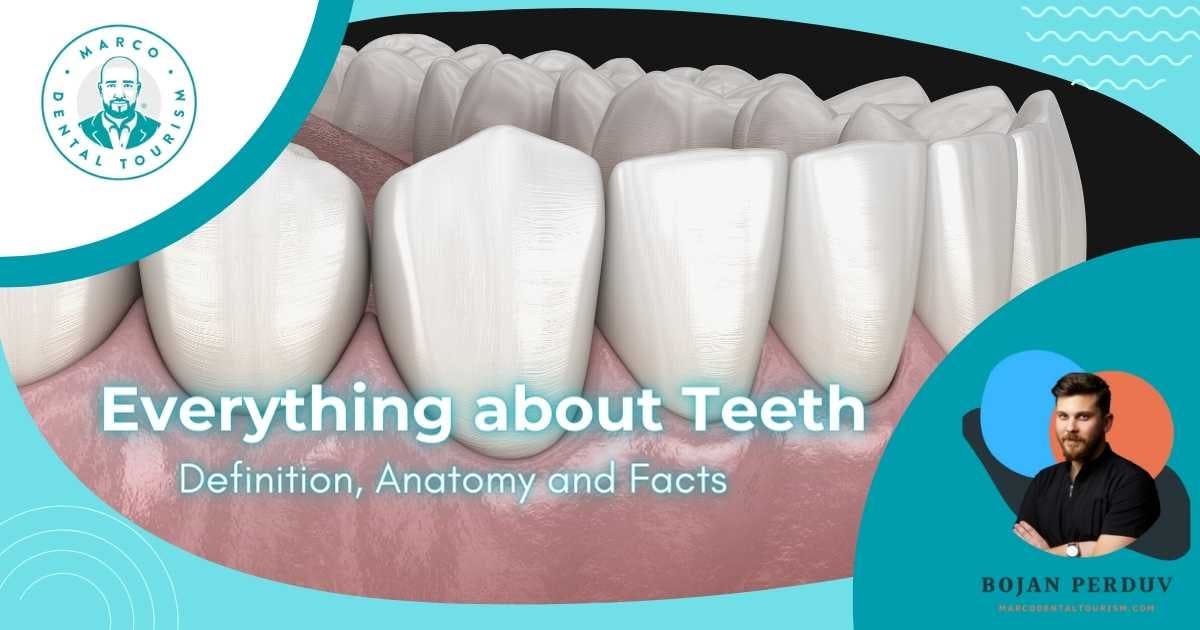Everything about Teeth in One Place
Da li možda znate kojim zubima žvaćemo hranu, a koji zubi nam omogućavaju da govorimo? U zavisnosti od lokacije i njihove funkcije, zubi se mogu podeliti na različite tipove. Bavimo se vrstama zuba, njihovom ulogom, strukturom i razvojem.
What types of teeth are there?
An adult usually has 32 teeth divided into four categories: incisors, canines, premolars, and molars. Different types of teeth have different shapes and functions. Incisors are used for chopping, canines for tearing, premolars for grinding, while molars are used for crushing food.
What are baby teeth?

Milk or temporary teeth are the first teeth that appear in the baby's mouth. They begin to appear around the sixth month, and last until the age of 12 or 13, when they are replaced by permanent teeth. Baby teeth are important for several reasons. They help develop the muscles of the face and jaw, which are important for proper speech.
How are our teeth classified?
Teeth are held in place by various ligaments and muscles, which allow us to move them, chew and speak. According to the position they occupy and depending on the function they perform, our teeth are classified into four categories:
- Incisors: Incisors are small, sharp teeth located in the front of the mouth. There are eight in total: four on the upper jaw and four on the lower jaw. The main function of incisors is biting and chopping food.
- Canines: Canines are longer, pointed and sharper teeth that are positioned right next to the incisors, and there are four of them, two of which are at the top and two at the bottom of the jaw. Canines are used for tearing or chopping food.
- Premolars or premolars: Premolars are the eight teeth located between the canines and molars. They are characterized by a flat surface with two protrusions, and their role is to crush or grind food.
- Molars or molars: Molars are large flat teeth located in the back of the mouth that allow us to chew food.
What is the structure of human teeth?
The structure of the tooth is very complex because it consists of four different types of tissue, which makes it one of the hardest structures in our body. The main tissues that make up our teeth are the following:
- Tooth enamel: The hardest and most mineralized tissue in the body, enamel, is the outer white layer whose role is to preserve and protect teeth not only from external influences but also from bacteria and other substances that can cause dental caries and pain inside the tooth.
- Dentin: Dentin is the yellowish layer located just below the tooth enamel. It's not as hard as tooth enamel, but it's still pretty strong. Dentin is a living tissue and contains tiny channels that lead to the pulp of the tooth.
- Cementum is a mineralized connective tissue consisting of collagen fibers that covers the surface of the tooth root. Cement helps anchor the tooth in the jawbone and protect the root surface.
- Pulp: The dental pulp is the soft tissue inside the tooth that contains blood vessels, nerves, and lymphatic channels. The pulp is responsible for the nutrition and hydration of the teeth.
What are the development stages of our teeth?
Tooth development, or odontogenesis, is the process by which teeth are formed from embryonic cells, grow and erupt. This process begins before birth and continues until a full set of adult teeth is achieved. Although the timing of tooth development varies from person to person, the basic sequence of events is the same:
- The enamel organ is the first structure to form during tooth development. This structure creates enamel, the hard, outer layer of the tooth. The eye organ consists of two layers of cells: an outer layer of cells, called the epithelium, and an inner layer of cells, called the mesenchyme. The cells that form the enamel arise from the epithelium, while the mesenchyme forms connective tissue and blood vessels. The organ of vision begins to form around the sixth week of development and continues until birth.
- Dentin is the hard, bone-like tissue that makes up most of the tooth. Dentin begins to form during the second year of life and continues to grow throughout childhood and adolescence.
- The tooth root consists of connective tissue and blood vessels. The root begins to form during the third year of life and continues to grow until the tooth reaches its full size.
- The crown stage is the final stage of tooth development. During this stage, the tooth grows and erupts into the mouth. The enamel and dentin of the tooth are formed, and the tooth is fully functional.
Until what age do baby teeth grow?

Baby teeth continue to grow until about age six or seven. This is the time when baby teeth start to fall out and are replaced by permanent teeth. However, not only teeth grow during this time. The entire jaw grows and changes shape, which is why it is very important for children to have a healthy diet and good oral hygiene habits.
When do wisdom teeth start to grow?
Wisdom teeth grow in late adolescence or early adulthood. While some people never have problems with wisdom teeth, for others they can cause a lot of tooth pain and problems if they don't have enough space to break out properly. This can cause pain, swelling, and more dental problems.
How to prevent irregular tooth growth?

Caries and gum disease are the primary causes of improper tooth growth. To prevent these conditions, it is important to brush and floss daily, as well as visit your dentist regularly for a professional examination and cleaning.
In addition to daily brushing and flossing, there are a few other things you can do to prevent improper tooth growth:
- Practice a healthy diet: A diet high in sugars and starches can contribute to tooth decay. Eat lots of fruits, vegetables, and whole grains, and limit sugary snacks and drinks.
- Use fluoride: Fluoride helps prevent tooth decay by making teeth more resistant to decay-causing acids. Fluoride is found in toothpaste and mouthwashes, and there are also professional treatments at your dentist's office.
- Limit acidic drinks: Fizzy drinks can contribute to tooth decay. If you do consume them, drink them through a straw and then rinse your mouth with water.
- Reduce your tobacco intake: Smoking increases the risk of gum disease and tooth decay. If you smoke, it would be best if it were moderate and occasional.
In the end, it is not important that the teeth are completely correct in order to perform the same basic and vital life functions. Our teeth are designed to help us chew food, speak clearly, and maintain a healthy smile. Although there are many different types of teeth, some of which may appear more perfect, they are all created solely to help us enjoy good dental health throughout our lives.








Share your opinion!
What do you think about this topic?
Comments (0)